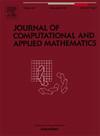Optimal error estimates for the semi-discrete and fully-discrete finite element schemes of the Allen–Cahn equation
IF 2.1
2区 数学
Q1 MATHEMATICS, APPLIED
Journal of Computational and Applied Mathematics
Pub Date : 2025-01-01
DOI:10.1016/j.cam.2024.116469
引用次数: 0
Abstract
In this paper, we study the numerical approximation of the Allen–Cahn(AC) equation. Firstly, based on the Lagrange multiplier strategy, we present an equivalent form of the AC equation. Secondly, we provide corresponding semi-discrete and fully-discrete finite element schemes which satisfy the energy law of dissipation. Thirdly, we derive optimal error estimates of the semi-discrete and fully-discrete schemes. That is, by eliminating the Lagrange multiplier of the above discrete schemes, we obtain equivalent equations with only the phase field variable, then we establish the bounds and bounds of the numerical solution using mathematical induction. Due to the spatial discretization of the fully-discrete scheme, we derive more necessary conclusions to make preparation for the optimal error estimation. With the use of the spectrum argument, the superconvergence property of nonlinear terms and the mathematical induction, we obtain error bounds that solely depend on low-order polynomial of rather than the exponential factor . Finally, we present some numerical experiments to validate our theoretical convergence analysis.
求助全文
约1分钟内获得全文
求助全文
来源期刊
CiteScore
5.40
自引率
4.20%
发文量
437
审稿时长
3.0 months
期刊介绍:
The Journal of Computational and Applied Mathematics publishes original papers of high scientific value in all areas of computational and applied mathematics. The main interest of the Journal is in papers that describe and analyze new computational techniques for solving scientific or engineering problems. Also the improved analysis, including the effectiveness and applicability, of existing methods and algorithms is of importance. The computational efficiency (e.g. the convergence, stability, accuracy, ...) should be proved and illustrated by nontrivial numerical examples. Papers describing only variants of existing methods, without adding significant new computational properties are not of interest.
The audience consists of: applied mathematicians, numerical analysts, computational scientists and engineers.

 求助内容:
求助内容: 应助结果提醒方式:
应助结果提醒方式:


